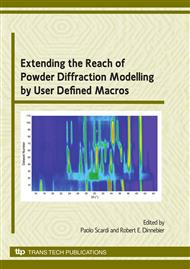p.1
p.11
p.27
p.37
p.65
p.71
p.79
p.97
In Situ Diffraction Studies: Thermal Decomposition of a Natural Plumbojarosite and the Development of Rietveld-Based Data Analysis Techniques
Abstract:
A study of the thermal decomposition sequence of a sample of natural arsenian plumbojarosite has been undertaken using in situ X-ray diffraction. The sample was heated to 900°C using an Anton-Paar heating stage fitted to an INEL CPS120 diffractometer. The data were analysed using a whole-pattern, Rietveld based approach for the extraction of quantitative phase abundances. The instrument configuration used required the development and application of algorithms to correct for aberrations in the (i) peak intensities due to differing path lengths of incident and diffracted beams in the sample and (ii) peak positions due to sample displacement. Details of the structural models used were refined at selected steps in the pattern and then fixed for subsequent analysis. The data sequence consists of some 110 individual data sets which were analysed sequentially with the output of each run forming the input for analysis of the next data set. The results of the analysis show a complex breakdown and recrystallisation sequence including the formation of a major amount of amorphous material after initial breakdown of the plumbojarosite.
Info:
Periodical:
Pages:
37-64
Citation:
Online since:
May 2010
Authors:
Price:
Сopyright:
© 2010 Trans Tech Publications Ltd. All Rights Reserved
Share:
Citation:


